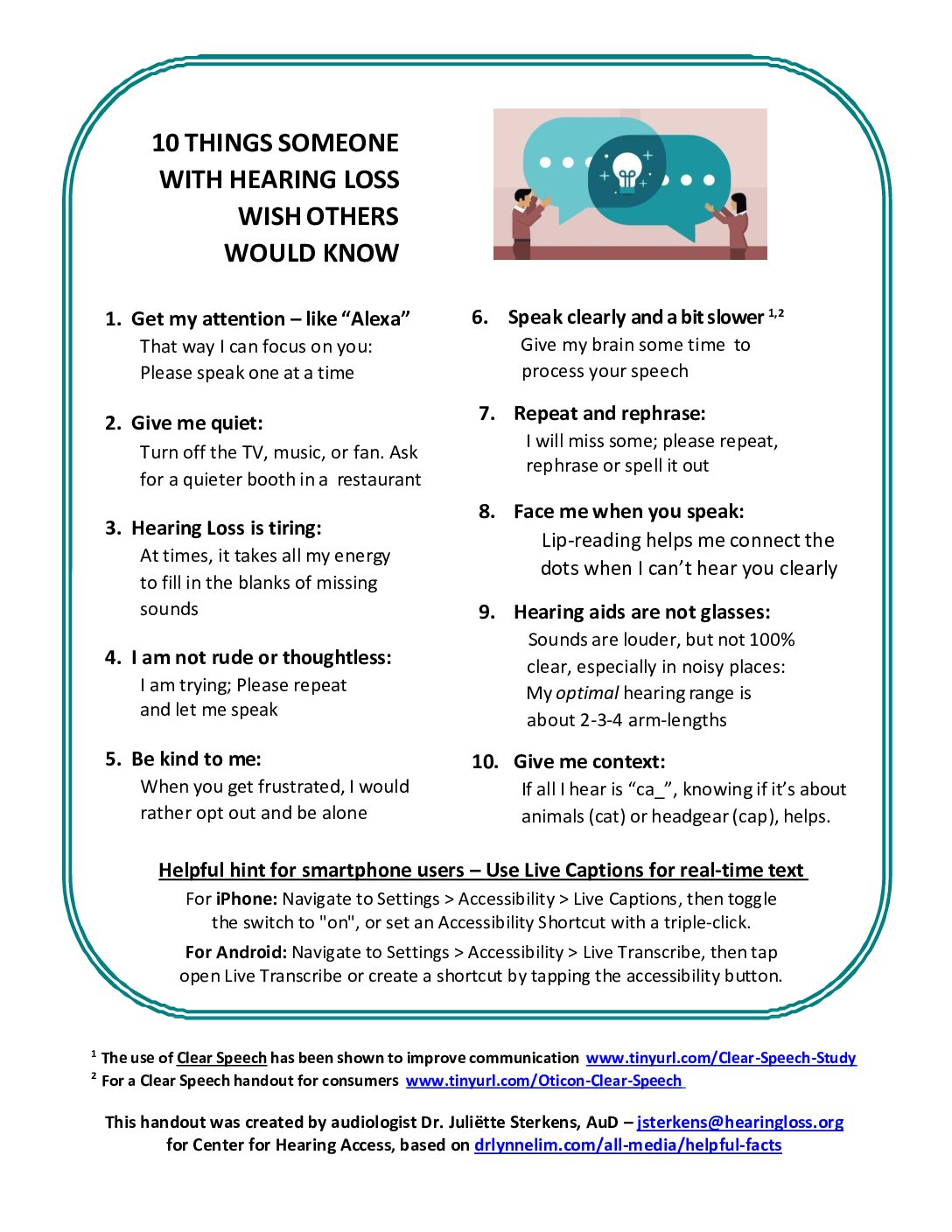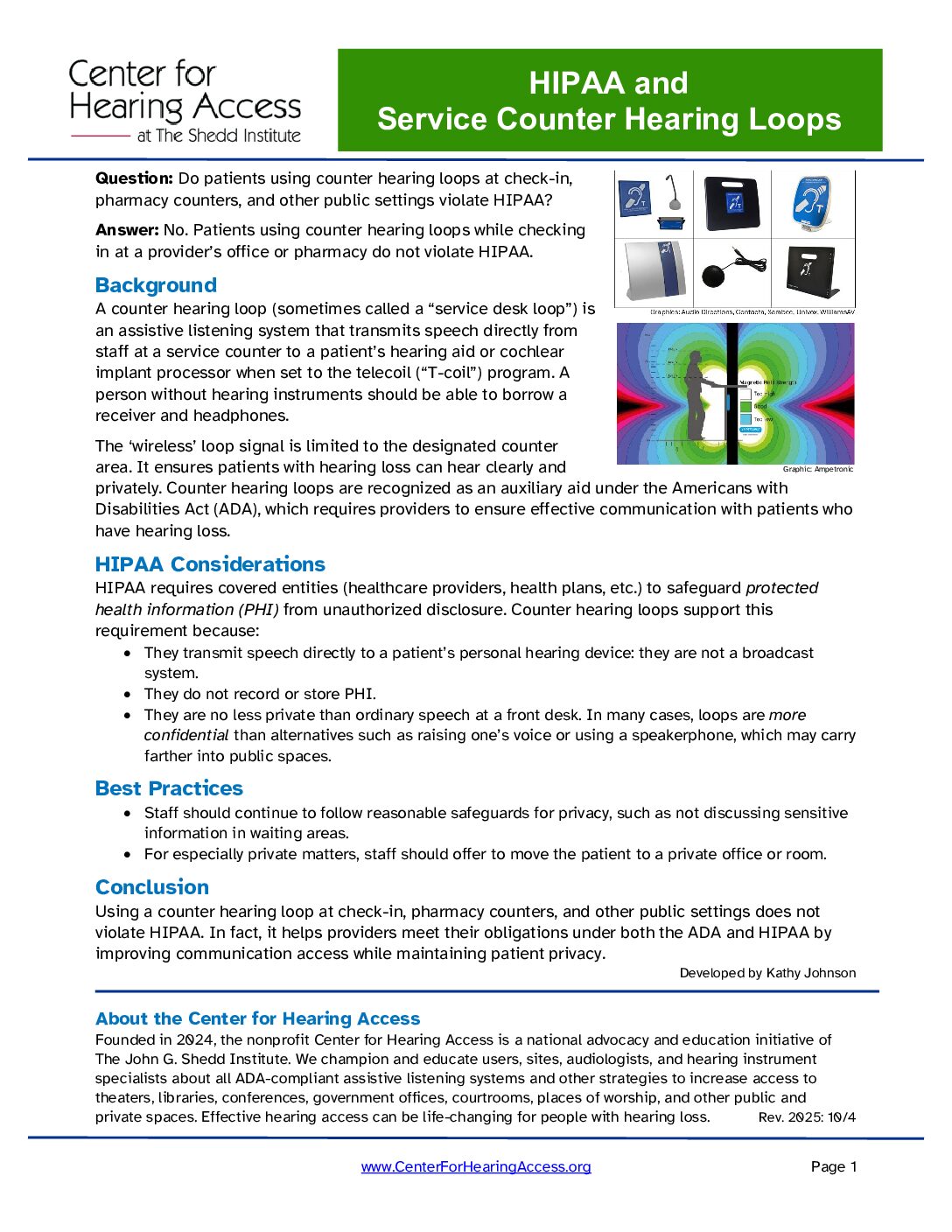Healthcare Communication Access
With improved healthcare communication access for people with hearing loss, health outcomes can be enhanced, costs reduced, and equitable care promoted.
Additional auxiliary aids and services for people with hearing loss: Technology for People with Hearing Loss in the Healthcare setting (this webpage). Includes captions and personal amplification devices.
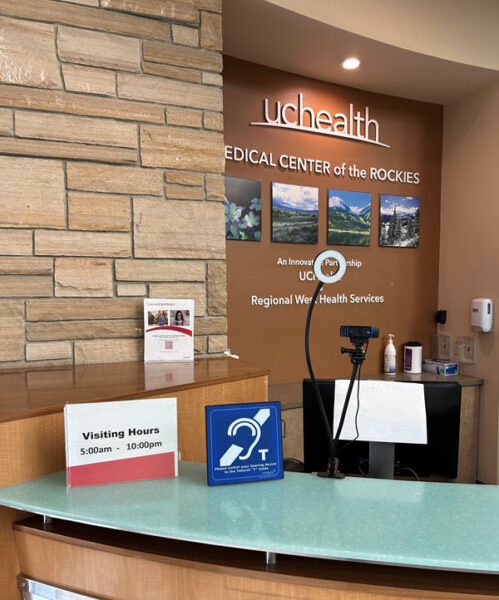
Permanently installed counter hearing loop at the front desk. UCHealth Medical Center of the Rockies, Colorado
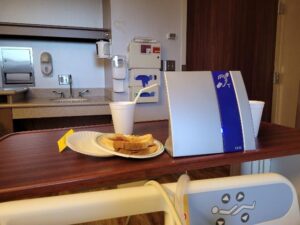
Portable counter hearing loop on bedside table at Nebraska hospital.

Counter hearing loops at check-in counters at medical offices. Photo credit: Audio Directions
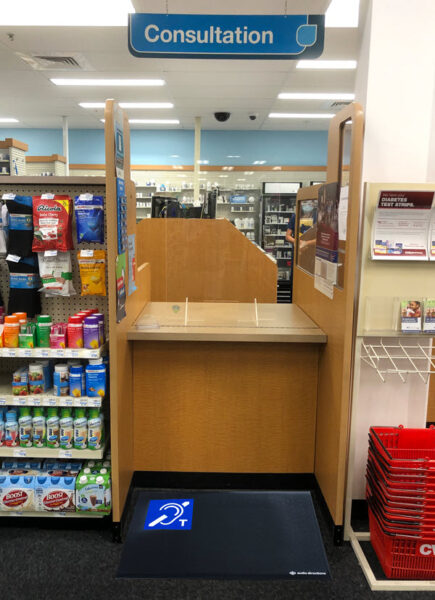
Floor mat hearing loop in front of pharmacy counter. Photo credit: Audio Directions
A doctor visit or hospital stay can be stressful enough, but if you do not hear well, that stress is compounded because of the critical nature of the information being disseminated. It is essential for the patient’s health and well-being that they clearly understand doctors’ and medical staff ‘s instructions. Understanding and asking appropriate questions can avoid mistakes and misunderstandings, which helps the patient to make reasoned decisions and get the safest and best care possible.
Covered health care facilities include, but are not limited to: hospitals, doctors’ offices, pharmacies, dentists’ offices, acupuncturists’ offices, etc. Health care agencies run by state and local governments are covered under Title II of the ADA. Health care organizations run by private businesses or nonprofit organizations are covered under Title III of the ADA. All places covered by the ADA must provide access to their facilities and programs for people with disabilities.
“People may not always want to disclose an inability to hear, especially if it isn’t the reason for the consultation.”
—Inclusive environments for patients with hearing loss, 21 Feb 2025
Possible Assistive Listening System Locations
- Service desks: emergency room check-in, information desk, pharmacy (Counter hearing loops)
- Individual patients: consultation, patient room (Portable counter hearing loop, portable FM system)
- Rooms: auditoriums, community rooms, chapel (Permanent hearing loop, FM, IR)
Because communication is a cornerstone of patient safety and quality care, every patient has the right to receive information in a manner he or she understands. Effective communication allows patients to participate more fully in their care. When a patient understands what is being said about his or her care, treatment, and services, that patient is more likely to fulfill critical health care responsibilities. Communicating effectively with patients is also critical to the informed consent process and helps practitioners and hospitals give the best possible care.
—The Joint Commission Comprehensive Accreditation Manual for Hospitals , “Rights and Responsibilities of the Individual” Chapter, Introduction to Standard R1.01.03 (2019)
I have taken the portable loop with me to all of my doctors appts and have found it extremely helpful. I hear everything and I don’t have to ask them to repeat themselves when I don’t hear them. I have also taken it as an opportunity to talk with them about having portable hearing loops at their reception desks as well as one box available to use in the doctors office when someone is struggling to hear. As you can imagine I have had a variety of responses—some listened to my reasoning for why it was important for them to have these devices available and asked questions and others just blew me off. It gives me new insights into the quality of communication I am receiving from different health care providers.
Resources
updated 9/1/25
- Center for Hearing Access
- Paragraph template and checklist. Describe your assistive listening system on your webpage. Promoting Your Assistive Listening System, with Checklist by the Center for Hearing Access (2 pages, pdf)
- Templates for facilities/sites: graphics, audio pre-event, handouts, ideas.
- Lists of hearing loops across the United States and Canada.
- Library
- Zotero online library (healthcare) with articles, websites, and examples (webpage)
- Zotero online library (pharmacies) with articles, websites, and examples (webpage)
- HLAA (Hearing Loss Association of America)
- Toolkit (patients and providers), Guide for Effective Communication in Health Care (34 pages, pdf)
- Program, Communication Access in Health Care (webpage)
- Articles
- McCaffrey, E. and C. McCaffrey (Spring 2025). My Journey from Caregiver to Patient to Advocate Hearing Life Magazine (2 pages, pdf)
- Morris, M. et. al. (Fall 2022). Why is it So Hard to Get the Health Care Accommodations that I Need? Hearing Life Magazine (2 pages, pdf)
- Webb, A. (Spring 2022). Effective Communication in Medical Settings: Your Rights Under the Law. Hearing Life Magazine (2 pages, pdf)
- Quarterly articles, patient stories (webpage, each article is 2 pages)
- Articles
- Thomas, Andrew (Feb 21, 2025) Inclusive environments for patients with hearing loss,
- Jawadi, Z., McInturff, S., & Chern, A. (May 28, 2024). Achieving telehealth equity for people with hearing loss. STAT.
- Shirley, T. Communication Access Realtime Translation (CART) White paper on captions. (1 page)
- Short Videos
- Runnion, E. et. al. (2025). Effective Communication For Hospital Patients With Hearing Loss (5:25 minutes) by Students of Dr. Elizabeth Runnion at Nazareth University & HLAA Rochester NY Chapter Healthcare Taskforce
- Pocker, R. (2024). Enhancing Healthcare: A Guide for Interacting with Individuals with Hearing Loss, individual contributor, (4 minutes)
- Other Resources
- ACCESS is a framework of six core principles. Better Health Starts with Effective Communication. People with communication disabilities often find it hard to get the information and communication supports they need to fully access health services and programs. This can lead to less than ideal outcomes for everyone involved. American Speech-Language-Hearing Association (ASHA)
- Comorbidities correlations article. Beck, D. et al. (Feb 18, 2025) Untreated Hearing Loss, Hearing Aids, and Cognition: Correlational Outcomes 2025, HearingTracker.
- Medicare (November 2023). Improving Access to Care for People with Disabilities with a handout Improving Communication Access for Individuals Who Are Deaf or Hard of Hearing (20 pages, pdf)
- ADA Business Brief (August 11, 2005). Communicating with People Who Are Deaf or Hard of Hearing in Hospital Settings (webpage)
- Facility Guidelines. Optimizing acoustic environments at healthcare facilities, Quiet Communities (webpage)
- Letter to healthcare providers. National Association of the Deaf (NAD) (updated 8/22/17) seeks to ensure that all healthcare providers, including doctor’s offices and hospitals, understand their legal obligations with respect to serving deaf and hard of hearing patients and companions. Many references to “Auxiliary aids and services” which includes assistive listening systems. Advocacy letter (13 pages, pdf)
Legal Resources
- Webinars
- Pacific ADA Center (8/27/25). Creating Inclusive Medical Environments. Not uploaded yet.
- ADA Webinar (4/16/25). Your Rights As A Person with A Disability Under the ADA in Health Care (1 hour)
- ADA Webinar (8/22/24). ADA’s Effective Communication requirements in healthcare settings (webpage). Includes link to slides (pdf). Steve Gordon.
- ADA Webinar (8/22/24). Healthcare and the ADA Webinar: Personal Experiences with Healthcare Barriers & the ADA video archive (webpage)
- Webinar (5/3/23). Sweet. Kara, and Steve Gordon. “Episode 117: ADA and Effective Communication in Health Care Settings with the Department of Justice – ADALive!” (webpage). PowerPoint slides (pdf)
- ADA Healthcare Webinar Series. 16 recorded webinars (webpage). The series topics cover physical accessibility, effective communication, and reasonable modification of policy issues under the Americans with Disabilities Act of 1990 (ADA). (webpage)
- Federal
- Fact Sheet. Telehealth and Federal Disability Laws (October 11, 2023) Pacific ADA Center.
- Final HHS Ruling (4/26/24). The U.S. Department of Health and Human Services (HHS) Office for Civil Rights (OCR) and the Centers for Medicare & Medicaid Services (CMS) issued a final rule under Section 1557 of the Affordable Care Act (ACA) advancing protections against discrimination in health care. New Rule to Strengthen Nondiscrimination Protections and Advance Civil Rights in Health Care (webpage)
- HHS final ruling, Section 504 (this website)
- Section 1557. Section 1557 Final Rule: FAQ (webpage) Section 1557 is the non-discrimination provision of the Affordable Care Act (ACA). The final rule requires effective communication, including through the provision of appropriate auxiliary aids and services.
- Centers for Medicare & Medicaid Services (5/6/2024). Nondiscrimination in Health Programs and Activities, Auxiliary aids and services.
- DOJ
- (4/14/23) U.S. Attorney’s Office Reminds Healthcare Providers of ADA’s Effective Communication Requirements (webpage)
- (4/13/23) Dear Colleagues Letter (3 pages, pdf)
- (updated 2014). Justice Department Announces Americans with Disabilities Act Barrier-free Health Care Initiative by US Attorney’s Offices Nationwide (webpage)
- ADA.gov, telehealth topic
- ADA settlements
- ADA settlements, including medical (this website)
Tools
How the hyperlinks work:
- image or title -> opens a new webpage with more information
- download icon at bottom -> direct download
